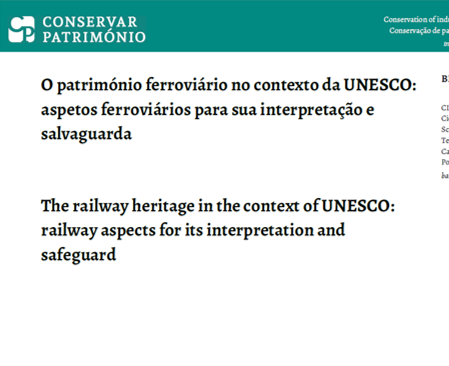The railway heritage in the context of UNESCO: railway aspects for its interpretation and safeguard
DOI:
https://doi.org/10.14568/cp29218Keywords:
Industrial heritage, Aspects, Cultural significance, PreservationAbstract
The industrial and railway protagonism in promoting economic, social and regional development in recent centuries is not reflected in international preservation policies. The industrial universe, and specifically the railway sector, has characteristics that demand a different interpretation from other cultural assets and little progress has been made in this regard over the 50 years of the Convention for the Protection of the World Cultural and Natural Heritage. In this way, the article contextualizes the creation of international heritage and the presence of industrial goods as World Heritage to justify the need for a new look at these goods. Within this problem, specificities of the railway heritage are presented and the proposition of eight aspects that provide the reading and interpretation of its main characteristics, responsible for the attribution of its heritage values and, consequently, its cultural significance.
Downloads
References
Unesco, Convenção para a proteção do património mundial, cultural e natural, Paris (1972), https://whc.unesco.org/archive/convention-pt.pdf (acesso em 2020-05-13).
Unesco, Guia operacional, Paris (1977), CC-77/CONF.001/8 (unesco.org) (acesso em 2023-07-22).
Unesco, Operational guidelines for the implementation of the world heritage convention (1980), https://whc.unesco.org/archive/opguide80.pdf (acesso em 2023-07-22).
Bitencourt, A. P., As Ferrovias como património cultural mundial: os estados-parte, a UNESCO e o valor universal excepcional, Dissertação de doutoramento, Departamento de Desenvolvimento Urbano, UFPE, Recife (2015).
Dezen-Kempter, E., O lugar do património industrial, Dissertação de doutoramento. Instituto de Filosofia e Ciências Humanas, Universidade Estadual de Campinas, Campinas, São Paulo (2011), https://hdl.handle.net/20.500.12733/1614661 (acesso em 2018-06-05).
Coulls, A.; Divall, C. M., ‘Railways as world heritage sites’, Locality 10 (1999) 7-11.
Carsalade, F. de L., ‘A preservação do património como construção cultural’, Arquitextos 12(139.03) (2011), http://www.vitruvius.com.br/revistas/read/arquitextos/12.139/4166 (acesso em 2023-07-22).
Viñas, S. M., Contemporary Theory of Conservation, Elsevier, Oxford (2005).
Anjos, C. C. dos., A proteção do património cultural ferroviário no Brasil entre 2000 e 2015: do tombamento à inscrição, um caminho de distanciamento das especificidades do objeto a preservar, Dissertação de mestrado, Departamento de Desenvolvimento Urbano, UFPE, Recife (2018), https://repositorio.ufpe.br/handle/123456789/32343 (acesso em 2018-12-07).
Soto, J. L. L.; Ganges, L. S., ‘Las fronteras del patrimonio industrial’, Llámpara: patrimônio industrial 2 (2009) 7-20, https://uvadoc.uva.es/handle/10324/1682 (acesso em 2023-07-22).
Casanelles-Rahóla, E., ‘Recuperacion y uso del patrimônio industrial’, Cadernos do Centro Latinoamericano de Economia Humana 88 (2004) 57-64.
Casanelles-Rahóla, E., ‘Nuevo concepto de patrimonio industrial, evolución de su valoración, significado y rentabilidade nel contexto internacional’, Revista Bienes Culturales 7 (2007) 59-70, http://www.mcu.es/patrimonio/docs/MC/IPHE/BienesCulturales/N7/11 (acesso em 2023-07-22).
Bergeron, L., ‘L’impact de la modernization économique et le patrimoine industriel’, in Identification and documentation of modern heritage - World Heritage papers 5, UNESCO World Heritage Centre, Paris (2003) 18-22.
Meneguello, C., ‘Patrimônio industrial como tema de pesquisa’, in Anais do I Seminário Internacional História do Tempo Presente, Universidade Estadual de Santa Catarina, Florianópolis (2011) 1819-1834.
Kühl, B. M., Arquitetura do ferro e arquitetura ferroviária em São Paulo: reflexões sobre a sua preservação, FAPESP, São Paulo (1998).
The International Committee for the Conservation of the Industrial Heritage, Carta de Nizhny Tagil para o património industrial, s.n., Nizhny Tagil (2003), https://ticcih.org/wp-content/uploads/2013/04/NTagilPortuguese.pdf (acesso em 2013-02-13).
The International Committee for the Conservation of the Industrial Heritage, , Princípios de Dublin: Conservation of industrial heritage sites, structures, areas and landscapes, Icomos (2011), Microsoft Word - GA2011_ICOMOS_TICCIH_joint_principles_EN_FR_final_20120110.doc (acesso em 2023-07-22).
Freire, M. E. L., Património ferroviário: a preservação para além das estações, Dissertação de doutoramento, Departamento de Desenvolvimento Urbano, UFPE, Recife (2017).
Soto, J. L. L., ‘Los ferrocarriles y el patrimonio mundial. Del monumento al paisaje cultural’, in VI Congresso de História Ferroviária, s.n., Vitoria (2012), https://www.docutren.com/historiaferroviaria/Vitoria2012/pdf/6046.pdf (acesso em 2018-12-10).
Rufinoni, M. R., Preservação e restauro urbano: Intervenções em sítios históricos industriais, Editora Fap-Unifesp, São Paulo (2013).

Downloads
Published
How to Cite
Issue
Section
Categories
License
This work is distributed under a Creative Commons Attribution License (CC BY-NC-ND 4.0) which permits use, distribution, and reproduction in any medium following no commercial or derivatives, provided the original author and source are credited.
Copyright remains with the authors.






